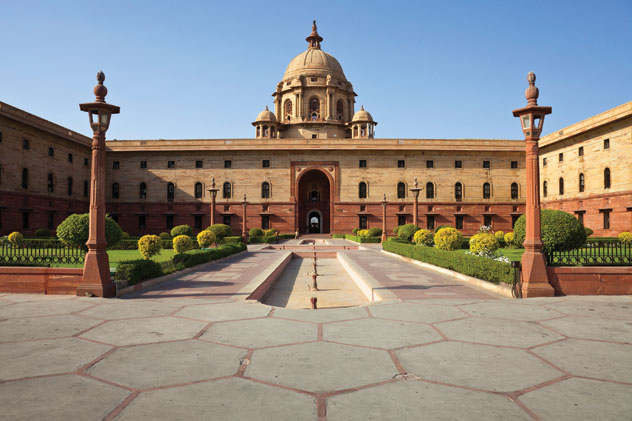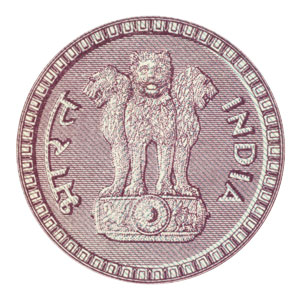POLITICS:
Guessing Game: The Next President of India
In three months time, India will have a new President. The big question — Who is going to be the Head of State and Commander-in-chief of India’s defense forces? Siddharth Srivastava contemplates possible contenders.

(Above): The Rashtrapati Bhavan in New Delhi.
With neither national party, the Congress that leads the federal government nor the Bharatiya Janata Party (BJP) enjoying majority numbers, a consensus will need to evolve with coalition partners and regional parties which is never an easy exercise.
The indirect election of India’s new President again underlines the country’s evolving political paradigm wherein no political party can have its absolute way.
Elected representatives of regional outfits and the Congress and BJP will form the Electoral College who will then elect the President. The BJP along with alliance partners or the Congress with supporting parties or the regional outfits amongst themselves could select the successful candidate for President.
The new President will need to be acceptable to at least a few outfits with separate or conflicting regional bases — Samajwadi Party (U.P.), AIADMK (Tamil Nadu), Left Parties (West Bengal and Kerala), Samata Party (Bihar), NCP (Maharashtra), Trinamool Congress (West Bengal), DMK (Tamil Nadu), Bahujan Samaj Party (UP), Biju Janata Dal (Orissa), TDP (Andhra Pradesh) among others.
A clutch of regional satraps ranging from Mamata Banerjee, Jayalalithaa, Sharad Pawar, Nitish Kumar, Naveen Patnaik, Mayawati, and Mulayam Singh Yadav among others will surely have some say in the way the nomination of Presidential candidates unfolds.
Given the emerging scenario, many eminent names are being spoken about, with regional, linguistic, religious, caste factors finding play, apart from achievements in professional or political spheres.
Those talked about include former chief minister of Jammu & Kashmir Farooq Abdullah, Speaker of Lok Sabha Meira Kumar and a dalit leader of prominence. Others include finance minister Pranab Mukhejee who belongs to Bengal, defense minister A.K. Antony from Kerala, power minister Sushil Shinde from Maharashtra, technocrat Sam Pitroda and the erudite Hamid Ansari.
 Those with a more pan-Indian appeal include the favorite of the middle classes, former President Abdul Kalam, a scientist with a distinguished previous tenure and even actress Waheeda Rehman known for her peerless looks and performances in Hindi movies in the past. Those with a more pan-Indian appeal include the favorite of the middle classes, former President Abdul Kalam, a scientist with a distinguished previous tenure and even actress Waheeda Rehman known for her peerless looks and performances in Hindi movies in the past.
There is talk that Kalam could be the consensus candidate of the regional parties, though there is no precedent of a former President coming out of retirement in India. Online bloggers, of course have their own favorites -- actor Amitabh Bachchan, even cricketer Sachin Tendulkar, making him the youngest ever President of India. This of course is too far fetched an idea.
India is a Parliamentary Democracy with executive powers resting with the Prime Minister, who leads the Cabinet. The President, however, is more than just a symbolic or ceremonial head of the Indian Republic. The political role of the Head of State can be critical in the context of disparate parties coalescing to form federal governments in the absence of clear majority winners.
The President can be the final arbitrator of who gets to be Prime Minister, at the first instance, and is most likely to form a government with majority support. Given such context, past selections have not always been transparent and above board with factors such as personal and party affiliations coming into play rather than just merit.
During long periods of absolute majority Congress rule in the past decades, Presidents have also been chosen for their sheer loyalty to the parent party. One example is Giani Zail Singh who combined a successful political career in Punjab with fierce allegiance to former Prime Minister Indira Gandhi.
Others have been selected on the basis of merit combined with minority community representation such as Muslim or Dalits, considered as the lowest and most downtrodden castes. The current incumbent Pratibha Patil belongs to Maharashtra with its Marathi populace and the first woman President of India. Selected by the Congress party five years back, her tenure has been low key and non controversial.
The current churn about the new President can also be seen as a sign of new dynamics in India democracy wherein crucial decisions need to be arrived via a consensus rather than absolutism. This for sure seems to be the likely scenario in the foreseeable future and the shape of Parliament in 2014 when general elections are due. They could be held earlier.
Both the Congress and the BJP will need to work out effective dialogue mechanisms with partners, often mercurial such as Mamata now, or Jayalalithaa in the past, to work out best case scenarios in pushing through policy changes or appointing important constitutional authorities.
One cannot be fully sure whether all of this is for the good or bad – if a personality such as Kalam, incidentally dumped by the Congress for Pratibha, gets to be President again, it would surely be a positive development. However, if an ultra-leftist such as Mamata Banerjee causes a policy paralysis at the Center, it can never be for the good.
Democracy has its imperfections. But, it still is the most perfect political system for nations to follow. That is for sure.
|